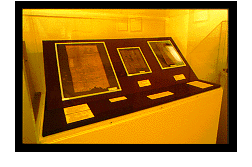![]()
 Much of what we know about gender in ancient
Egypt comes from textual evidence, which records the words, names, written
ideas, and practical record of gender in Egyptian thought and life. Texts
from ancient Egypt come in many media: inscribed on stone walls and monuments,
painted on wood, written on papyrus, and on the potsherds and flakes of
stone known as ostraca. Egyptian texts survive in many languages--the different
phases and scripts of the indigenous Egyptian language, as well as the languages
of foreign travelers, settlers, and conquerors in Egypt. Whether written
in Egyptian hieroglyphs, hieratic, Demotic, Coptic, Greek, Latin, or any
of the other languages and writing systems known from ancient Egypt, textual
evidence documents on many levels the conceptions and understandings of
gender. Religious and literary sources show ancient ideas about gender,
while the documents of daily life show how these ideals fared in the course
of everyday living.
Much of what we know about gender in ancient
Egypt comes from textual evidence, which records the words, names, written
ideas, and practical record of gender in Egyptian thought and life. Texts
from ancient Egypt come in many media: inscribed on stone walls and monuments,
painted on wood, written on papyrus, and on the potsherds and flakes of
stone known as ostraca. Egyptian texts survive in many languages--the different
phases and scripts of the indigenous Egyptian language, as well as the languages
of foreign travelers, settlers, and conquerors in Egypt. Whether written
in Egyptian hieroglyphs, hieratic, Demotic, Coptic, Greek, Latin, or any
of the other languages and writing systems known from ancient Egypt, textual
evidence documents on many levels the conceptions and understandings of
gender. Religious and literary sources show ancient ideas about gender,
while the documents of daily life show how these ideals fared in the course
of everyday living.
![]()